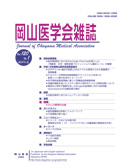

Journal of Okayama Medical Association
Published by Okayama Medical Association<Availability>
Full-text articles are available 3 years after publication.
Permalink : http://escholarship.lib.okayama-u.ac.jp/19319
P(32)による実験的流行性肝炎の研究 第1編 岡山県下に発生せる所謂流行性肝炎病毒接種マウス肝内に於ける燐代謝のSchneider法による研究
田辺 憲也
岡山大学医学部微生物学教室
発行日
1959-03-15
抄録
The phosphorous metabolism of the inoculated mouse liver with the pathogenic agent, that was isolated from infectious hepatitis patient in Okayama prefecture was studied by use of P(32). And the following result were obtained from the fact observed on each fractions of phosphorous that were separated by the Schneider's method. 1) The P(32) incorporation into acid-soluble fraction of phosphorous was increased at the early stadium of infection with the pathogene of hepatitis. This fact should mean the increased permeability of blood vessels of animal. 2) At the active stadium of infection it was noticed the increased phosphorous incorporation into the nucleic acid fraction, and, therefore, was supposed it was occured the severe change on the substance related to nucleic acid in the tissue. Conversely, at the late stadium phosphorous metabolism in nucleic acid fraction was suppressed. 3) From the early stadium of infection the phosphorous metabolism in the lipid fraction and protein fraction remained to be suppressed. 4) The phosphorous metabolism was affected in the higher dilutions of inoculum by the dilution test. And the most severe affection was observed at the dilution of 10(-6).
ISSN
0030-1558
NCID
AN00032489
